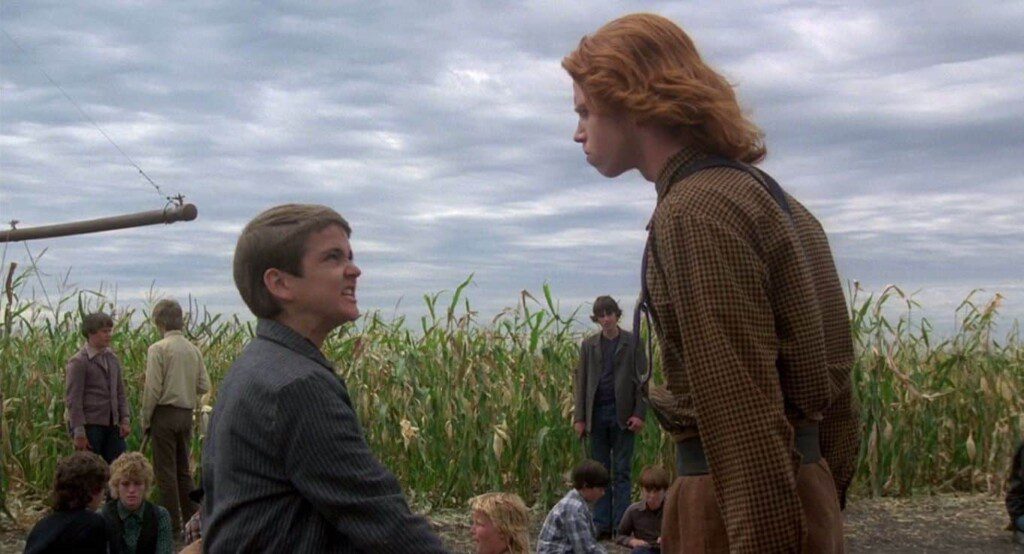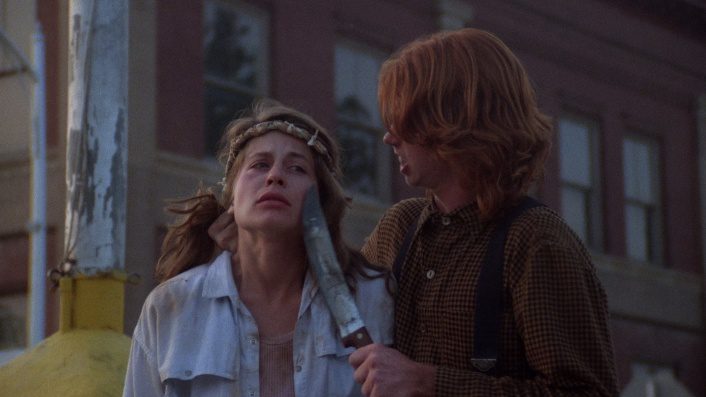“He Who Walks Behind the Rows will decide your fate.”
Look, it was the 1980s, okay? Putting Stephen King’s name on anything basically meant that you could print money. This was the era of The Shining, ‘Salem’s Lot, Carrie, Christine, The Dead Zone, Cujo, and Creepshow. The bloom hadn’t yet fallen off the rose, as it would in dramatic fashion with King’s only stab at directing a movie, Maximum Overdrive, a movie that, fun fact, rules. Reputable directors like Stanley Kubrick, David Cronenberg, Brian de Palma, and John Carpenter were putting their spins on King’s work. King was so popular that he was flooding his own market, so he had to publish concurrently with himself under the pseudonym Richard Bachman. So the existence of Children of the Corn makes complete sense. What makes less sense is basically everything else about it.
I’ve always wondered if a film’s iconography can transcend its quality, and the answer is a resounding yes. Friday the 13th endures despite being incompetent at every level, because Jason Voorhees makes for an instantly recognizable silhouette. So too does Children of the Corn endure, because King is adept at creating horrors that notch their way into our brains. Much like “Cujo” has become shorthand for an aggressive dog, now you wouldn’t be surprised to hear a group of creepy kids referred to as “children of the corn.”
Something people often forget about Stephen King is that he’s a terrifically gifted writer of short stories. And the thing about short stories is that they’re meant to be short. You can see Children of the Corn spinning its wheels in real time as it tries to hit feature length on an adaptation of a story that runs about fifteen pages (TBS’s Nightmares and Dreamscapes series, for its faults, knew that these things should be an hour, max). The end result of this is that we get some unnecessary backstory, more than a few pointless scenes, inconsequential deaths, and a voiceover that comes and goes (delivered by a character who is not the film’s protagonist).

You probably don’t need a refresher on the story, so we’ll be brief. We meet Burt (Peter Horton) and Vicky (Linda Hamilton) on their way to Seattle, where Burt is set to start practice as a doctor. Right away the film sands the edges off the story’s cantankerous couple, and it’s downright jarring to watch Hamilton be adorable. This came out the same year as the first Terminator film, which changed her image permanently. They’re making their way through Nebraska’s endless cornfields, and here I have to go on a digression that might change how you see the film.
There’s a copy of Night Shift on the dashboard of the car. Night Shift is Stephen King’s first collection of short stories, and among its contents is, you guessed it, “Children of the Corn.” So the story exists in-universe. That’s canon now. This begs the question, have the kids read it and are now reenacting it? Burt and/or Vicky own the book – do they realize they’re living the lives of the characters? Is this a Stranger Than Fiction situation? This is akin to the Ocean’s 12 conundrum. If you introduce the fact that Julia Roberts’ character looks like Julia Roberts, does that mean that Danny Ocean looks like George Clooney and Rusty Ryan looks like Brad Pitt? I am really crossed up now.
Anyway, those are the kinds of details that stick out to you when you’re watching a film that’s only as intermittently engrossing as this one. The two stories – that of Burt and Vicky, and that of the seemingly abandoned town of Gatlin, NE – collide, literally, as Burt accidentally runs over a kid in the middle of the road. This movie is probably more gruesome than you remember; I was genuinely shocked at the suddenness with which this kid is mowed down. Unfortunately, this also introduces a potentially ruinous decision on the filmmakers’ part: a cast that’s mostly children. You can’t adapt the story without it, but with only one exception the kid actors are terrible across the board. Look at the kid who plays the dead boy: he can’t even play dead! No, really, you can see his chest rising and falling.

As you already know, the town’s adults have all been murdered by the children, at the behest of a young preacher named Isaac, who enlists the kids in a cult that worships a bloodthirsty god called He Who Walks Behind the Rows (great name). As Isaac, John Franklin gives the best performance by a child in this movie, and it’s not even close. His main henchman is Malachai, played by Courtney Gains in a performance so bad you can almost hear the director saying “Well, shit, we’re not gonna get anything better out of him so let’s just move on.” Elsewhere, we have Job (our narrator, but only sometimes), who everyone insists on calling “Joby,” which is dumb, and his sister, Sarah, who in a twist the film really doesn’t need is somewhat clairvoyant. It’s just a hat on a hat and altogether unnecessary.
Night Shift was published in 1978, well before the height of the Satanic Panic of the mid-1980s, but Children of the Corn premiered in 1984 and played like gangbusters. (It grossed the modern equivalent of $43.3 million on a budget of a modern $6 million.) It’s an interesting inversion of the hysteria of the Satanic Panic: the idea of kids gone mad due to a warped form of Christianity as opposed to devil worship. Of course, the movie doesn’t quite know what to do with that idea, but it’s certainly there if you’re interested in it. (The writer, George Goldsmith, wrote it as an allegory of the Iran hostage crisis, with Burt and Vicky playing the American hostages.)
There’s an interesting kernel – no pun intended – of a story here, which is why King’s fifteen-page version is more successful than director Fritz Kiersch’s ninety-three minute version. Ultimately the movie is bogged down with scenes that go nowhere and have no narrative impact – do we really need more shots of kids’ hands picking up weapons, or Burt investigating yet another empty house, or the entire scene with the old man at the garage? There’s a decent hour of TV in this hour and a half of movie. But trying to find it is like looking for a needle in a haystack. Or a cornfield.

